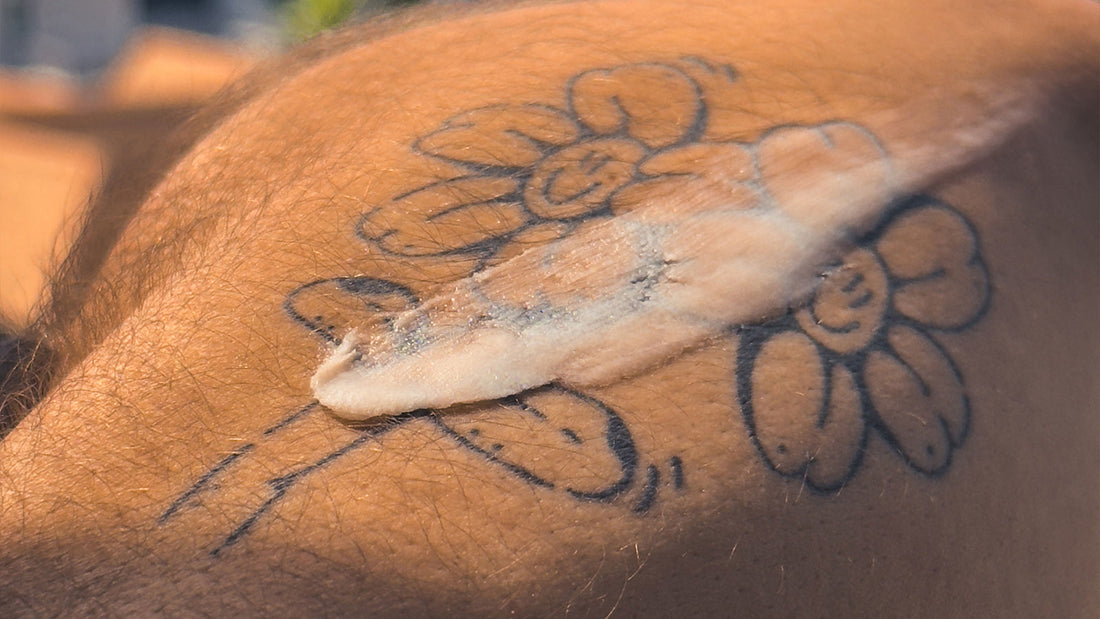
How to Heal Your Fresh Tattoo?
You've just finished your tattoo! While it’s exciting to have your new piece of art, taking care of it is very important. Specific treatment for your tattoo will heal well and keeps it looking awesome and sustainable for years. Follow this guide step by step to make sure everything goes smoothly.
Tattoo Healing process
Step 1: Immediate Care After Getting the Tattoo
When your tattoo is finished, the artist will cover it with a bandage or wrap. This is to protect the tattoo from dirt and germs while your skin starts to heal. You should keep this bandage on for 3 hours to 1 day, depending on the advice of your tattoo artist.
Step 2: Clean your tattoo carefully
Once you removed the bandage, You can use an antibacterial soap or a neutral pH soap to wash the tattoo. Avoid using casual soaps or harsh cleaning products that you can find in a supermarket, as these can irritate your skin.
Rinse with warm (not hot) water and dry the area gently with a clean towel. Never rub, as this can damage your skin and also your tattoo. Do not forget that the tattoo area is an open Sore. You really have to take care of it and avoid infections. So you have to use the good products at the good moment.
Step 3: Apply a healing product
During the first two weeks, use a tattoo-specific balm, cream, or lotion on the area. This keeps the skin moisturized and prevents it from becoming dry or cracked.Apply it 3 times a day, especially after washing the tattoo.
WARNING: Do not forget to ALWAYS use washed hands when touching your tattoo.
Things to Avoid During the Healing Process
During the healing phase, your tattoo is like an open wound, so it’s very important to protect it. Here’s what you should avoid:
- Stay out of the sun: Direct sunlight can fade your tattoo’s colors and make the skin more sensitive. If you must go outside, cover your tattoo with loose clothing.
- No swimming or soaking: Avoid swimming in pools, the ocean, or soaking in bathtubs. Water can introduce bacteria to the healing tattoo and cause infections.
- Don’t scratch or pick at the scabs: As your tattoo heals, it may itch or form scabs. This is normal, but don’t scratch or pick at it. Let the scabs fall off naturally, or you risk damaging the tattoo and causing scars.
- Avoid tight clothing: Wear loose-fitting clothes to avoid rubbing or irritating the tattoo.
Step 4: Continue your tattoo care routine
Your tattoo should be healed (that usually takes 2-3 weeks) and your skin might feel normal, but tattooed skin is always a little more sensitive than regular skin. If you want your tattoo to keep its colors bright and its lines crisp, you need to continue caring for it.
Here’s what you should do:
- Moisturize frequently: Apply some tattoo moisturizer/ Tattoo Balm to keep the skin soft and hydrated. This keeps the tattoo soft and bright. For long-term tattoo care, we recommend the Laysen Balm.
- Keep your tattoo covered from the sun: UV rays are one of the biggest culprits when it comes to fading tattoos. Apply a high-SPF sunscreen (such as SPF 50) to your tattoo whenever it is exposed to sunlight, especially in hot weather or during outdoor activities.
If you do these things on a daily basis, you can have a fresh and vibrant tattoo for years to come.
Why Is Aftercare Important?
Tattoo care isn’t just about making the design look good; it’s also about keeping you healthy. Proper tattoo aftercare:
- Stays vibrant and does not fade over the years.
- Makes sure details remain well-defined, particularly in complex designs.
- Prevents you from suffering unnecessary pain and medical issues from infections.
How well you take care of your tattoo in those first few weeks will help it look good for years to come.
Signs Something Is Wrong
Most tattoos heal without any problems, but it’s helpful to be aware of the signs of an issue. Watch out for:
- Redness that does not go away or gets worse.
- Red ring surrounding the tattoo with a white or hazy appearance.
- Discharge that is green or yellow and has a bad smell.
- Heat or warmth felt from the tattooed area.
- Swelling that won't go away.
- Red or black lines radiating outward from the tattoo.
- Fever or feeling sick.
- Heavy or thick scabs on larger tattoos.
If you are experiencing any of these signs, it is crucial to react quickly and contact a medical expert
Risks of Poor Healing
A poorly healed tattoo will leave lasting marks on its appearance:
- Blurred lines:;Little details and sharp lines begin to fade or look uneven.
- Color fading:;If a tattoo isn’t taken care of well or an infection takes place, some parts of the tattoo will lose color completely.
- Scarring:;Scratching, picking, or untreated infections can also lead to permanent scars in the tattooed area.
- Infections:;Untreated infections can cause severe health issues and permanent damage to the tattoo.
The best way to mitigate these risks is through proper care.